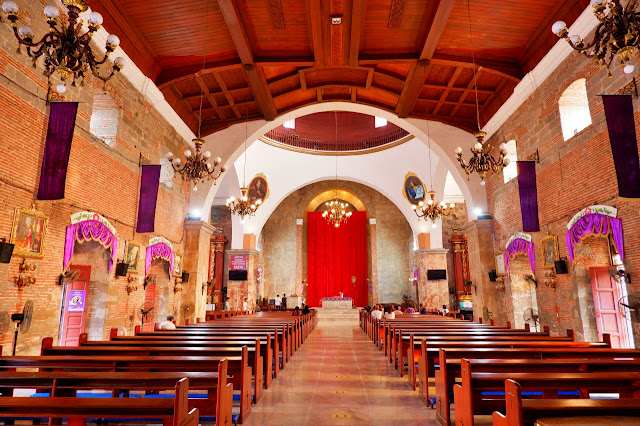During our Visita
Iglesia in Bulacan and Pampanga, we
also stopped by two churches in Nueva Ecija: St. John Nepomucene in Cabiao and,
before returning to Manila, the National Shrine of La Virgen Divina Pastora in
Gapan. This brought to 16 the number of churches we visited that day. After observing
the preparations for the Maundy Thursday Blessed Sacrament procession, we
wandered the streets of Old Gapan.
 |
| The ancestral home of Eula Valdez' great grandparents is this corner house. |
Gapan was formerly
a town founded by the Augustinians sometime around 1595, thus making it the
oldest town in Nueva Ecija. A row of
ancestral houses can be found along Jacinto and Delos Reyes Street, a few steps
from the National Shrine of La Virgen Divina Pastora, including the one owned
by actress Nida Blanca's parents, Eula Valdez's great-great grandparents, and
another old house sold to Jay Taruc's father, Joe.
Known as “Little Vigan,” but don’t call it as such
One of my pet
peeves when discussing places in the Philippines is when people compare them to
others. We’ve all heard the "New Zealand of the Philippines,"
"The Taj Mahal of the Philippines," "Little" this and that,
and the heritage streets of Old Gapan were not spared from this annoying
practice, when people initially branded it as “Little Vigan”.
 |
| The next house belongs to Jay Taruc's late father Joe Taruc |
While it is true
that the heritage district in Gapan is smaller compared to Vigan and other
preserved old quarters such as Hanoi and Hoi An, as it only covers two streets,
it should be referred to simply and appropriately as Old Gapan.
 |
| The home that originally belongs to Nida Blanca's parents |
Stepping out of the
Gapan Church compound, the first building to catch your sight is the Silvino
Valdez and Barbara Agno residence on the corner of Delos Reyes Street, both of
which feature superb woodwork and masonry craftsmanship.
 |
| Call the place by its name "Old Gapan" |
Along with the
historic homes of well-known families, visitors can also admire a couple of
buildings from before and after WWII. One of these is the Presidencia
(Municipal Building), which dates back to the early 20th century. The other is
a more modern structure, the Southern Nueva Ecija College, which was built
after WWII and is easily identifiable by its circular entrances and windows on
the ground floor.
 |
| This post-war building is one of the few newer structures in Old Gapan |
The intersecting
streets have been transformed into a pedestrian promenade with cobblestones and
vintage-style lampposts, however I did see some parked motorcycles and pedicabs
along the length of Old Gapan. A few more old houses can be found beyond the
stepped cobblestones, but they are surrounded by more modern commercial
facilities.
 |
| Old Gapan at nighttime |
Taking a leisurely
stroll through the Old Gapan Heritage District should only take about 10
minutes, but if you want to stop and admire the ornate details of the historic
houses, you may easily spend more than an hour doing so — and believe me, it’s one
fun and insightful walking experience, so better take your sweet time.
Gapan Church: National
Shrine of La Virgen Divina Pastora
The National Shrine of La Virgen Divina Pastora or otherwise known as Gapan Church and the Three Kings Parish, is Nueva Ecija's oldest and largest church, having been founded originally by the Augustinians in 1589. The church has served as a pilgrimage venue for devotees of two patron saints of Gapan and Nueva Ecija: the Three Kings and the Divina Pastora. On April 26, 1986, the Catholic Bishops Conference of the Philippines proclaimed the church a National Shrine while on January 22, 2024, Pope Francis bestowed the title of "Minor Basilica" to the shrine.
 |
| National Shrine of La Virgen Divina Pastora |
The current
appearance of the church, which is Byzantine in style and constructed from
solid blocks of bricks and limestone, is a result of the last major
restorations that took place from 1856 to 1872.
 |
| During Holy Week, churches cover their altars as a symbol of shared atonement. |
Inside the church,
devotees pay homage to the picture of La Virgen Divina Pastora, which dates
back to the 18th century and is believed to have been gifted by the Valmonte
family. Specifically, it is believed to have been bequeathed by Doña Juana
Valmonte, daughter of Don Bartolome de la Cruz Valmonte, who was the first Gobernadorcillo
of Gapan, having served in 1747.
 |
| Start of the Maundy Thursday procession in Gapan Church |
Taking our sweet
time walking the streets of Old Gapan and back to the church as the Maundy
Thursday procession started to brew, it was already nighttime when we decided
to leave for Manila. As we made our way back to the car, I couldn't help but
gawk at the beautifully weathered houses of Old Gapan, which were much more
picturesque in the brightly illuminated light. I imagined a time long gone and
wondered how it feels to live in the olden times inside one of these beautiful
houses.






















